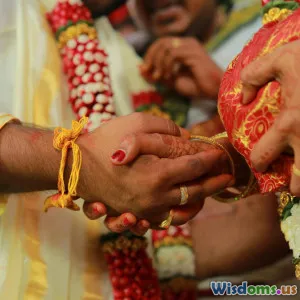
Cultural Heritage and Family Identity
8 min read Explore how cultural heritage shapes family identity and the role it plays in marriage and family life across generations. (0 Reviews)
Cultural Heritage and Family Identity in Marriage & Family Life
Introduction
Imagine a tapestry woven over generations—each thread embodying traditions, beliefs, and stories handed down from ancestors. This tapestry is the cultural heritage that forms the backbone of family identity. In the realm of marriage and family life, cultural heritage is not just a background detail; it fundamentally shapes how families define themselves, communicate, celebrate, and resolve conflicts. Why does cultural heritage matter so much in shaping family identity? How does it influence marital bonds and the upbringing of children? This article delves into these questions, exploring how culture is intimately tied to family identity and what that means for couples and families navigating an increasingly globalized world.
Understanding Cultural Heritage and Family Identity
Defining Cultural Heritage
Cultural heritage encompasses the traditions, languages, rituals, values, and artifacts inherited from previous generations. It is both tangible (like family heirlooms or traditional clothing) and intangible (such as storytelling, culinary customs, or moral principles). UNESCO defines cultural heritage as "the legacy of physical artifacts and intangible attributes of a group or society that are inherited from past generations." This heritage shapes worldviews and practices unique to each family and community.
What Is Family Identity?
Family identity refers to the shared sense of belonging and common values that give a family their unique character. It includes the collective memories, roles, and cultural norms that influence how family members perceive themselves and interact with the wider community. A robust family identity promotes cohesion, resilience, and intergenerational continuity.
Cultural Heritage’s Role in Marriage
Influencing Partner Selection and Marriage Rituals
Cultural heritage often guides whom one marries and the rituals observed during weddings, which are rich ceremonies reinforcing family identity. For example, in many Indian families, arranged marriages uphold cultural endogamy to maintain lineage and caste identity. Traditional wedding elements—such as the Mehndi ceremony or the Chinese tea ceremony—communicate respect for ancestral customs and symbolize merging family identities.
Navigating Cross-Cultural Marriages
In today’s multicultural societies, marriages between partners from different cultural backgrounds are increasingly common. These unions highlight how cultural heritage both enriches and challenges family identity.
Example: Couples blending Irish and Filipino cultures might combine St. Patrick’s Day celebrations with traditional Filipino fiestas like Simbang Gabi, thereby creating a hybrid cultural narrative. However, disagreements often arise over which traditions to prioritize or how to raise children, making dialogue vital.
Preserving Cultural Heritage Through Marriage
Marriage becomes a vehicle through which cultural heritage is preserved and adapted. Couples often consciously decide to teach their children ancestral languages, celebrate cultural holidays, or practice traditional arts. Such continuity fortifies family identity in the face of modernization and globalization.
Family Identity in the Context of Parenting
Transmitting Values and Cultural Norms
Parents play a critical role in transmitting cultural values that shape children's self-concept and moral frameworks. For instance, many Native American families emphasize the value of community interconnectedness and respect for nature, teachings that influence daily life and decision-making.
Identity Formation in Children
Research shows that children with a strong sense of cultural heritage exhibit higher self-esteem and better social adjustment. Understanding their roots helps them navigate identity conflicts, especially in multicultural settings.
For example, a 2019 study by the American Psychological Association found that adolescents engaged in cultural traditions at home had greater resilience and psychological well-being.
Challenges of Cultural Dissonance
Families must sometimes contend with cultural dissonance when younger generations adopt different values from their elders. This gap may manifest as conflict but can also foster dialogue leading to evolved family identities that respect the past while embracing the future.
Cultural Heritage Strengthening Familial Bonds
Celebrations and Rituals as Acts of Identity
Festivities such as Lunar New Year, Diwali, or Passover do more than mark time; they affirm family connections through shared cultural identity and history. These rituals create lasting memories that bind family members across generations.
Storytelling and Oral Traditions
Passing down family stories conveys values and history, helping members understand their place in a lineage that transcends individual lifetimes.
Example: The Maori people of New Zealand use storytelling (whakapapa) to link individuals to ancestors, land, and tribal identity, reinforcing family cohesion.
Resilience Through Shared Heritage
Shared cultural heritage offers families a framework to cope with adversity. During crises, cultural rituals and collective memory can be sources of comfort and unity.
Practical Steps for Families Embracing Cultural Heritage
- Document Family History: Create family albums or digital archives including stories, photos, and artifacts.
- Celebrate Traditions: Maintain and celebrate cultural holidays together, inviting younger generations to participate actively.
- Learn Ancestral Languages: Even basic language skills foster connection to heritage.
- Engage in Cultural Education: Attend cultural events or museums to deepen understanding.
- Encourage Open Conversations: Talk across generations about experiences, beliefs, and values to build shared understanding.
Conclusion
Cultural heritage is much more than relics of the past; it is a living source of family identity that shapes marriages, parenting, and the very essence of belonging. In honoring their cultural roots, families not only preserve traditions but also empower present and future generations to navigate life with resilience, purpose, and pride. Whether through wedding ceremonies, storytelling, or daily rituals, cultural heritage forms the threads of connection that weave individual members into an enduring familial tapestry. Embracing this heritage consciously is, therefore, one of the most profound ways to strengthen family identity and enrich the experience of marriage and family life.
References:
-
UNESCO. (n.d.). What is Cultural Heritage? Retrieved from https://whc.unesco.org/en/culturallandscape/
-
American Psychological Association. (2019). Cultural Engagement and Psychological Well-being Among Adolescents.
-
Durie, M. (2003). Ngā Kāhui Pou Launching Māori Futures. Huia Publishers.
-
Pew Research Center. (2020). Intermarriage in the U.S.: Enhancing Cultural Connections.
By embracing and integrating cultural heritage, couples and families on every continent enrich the human story while nurturing their shared identity. This commitment fosters resilience, understanding, and love, essential elements of thriving family life.
Rate the Post
User Reviews
Popular Posts




















